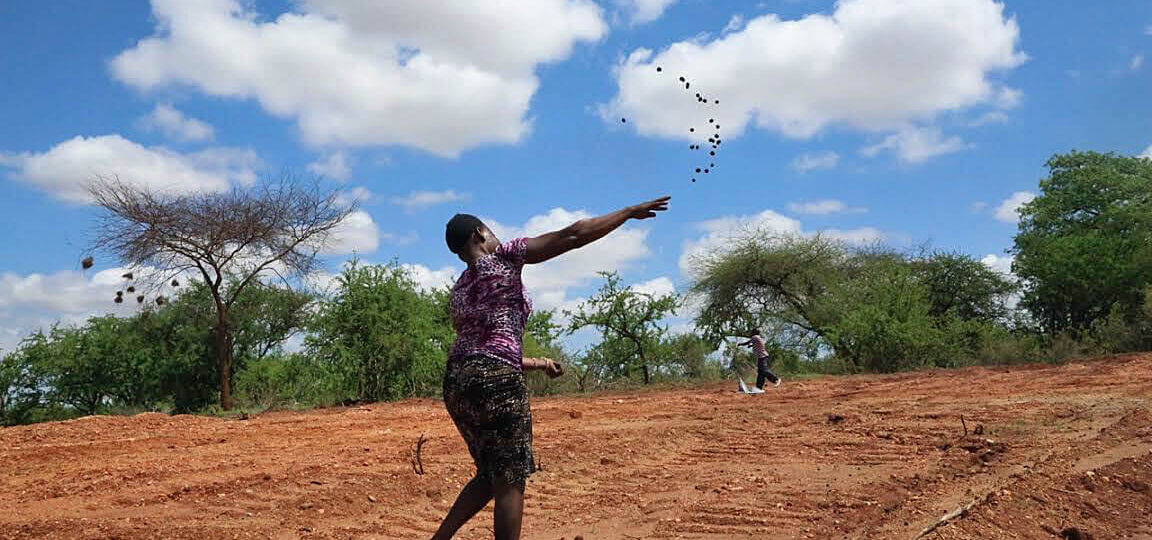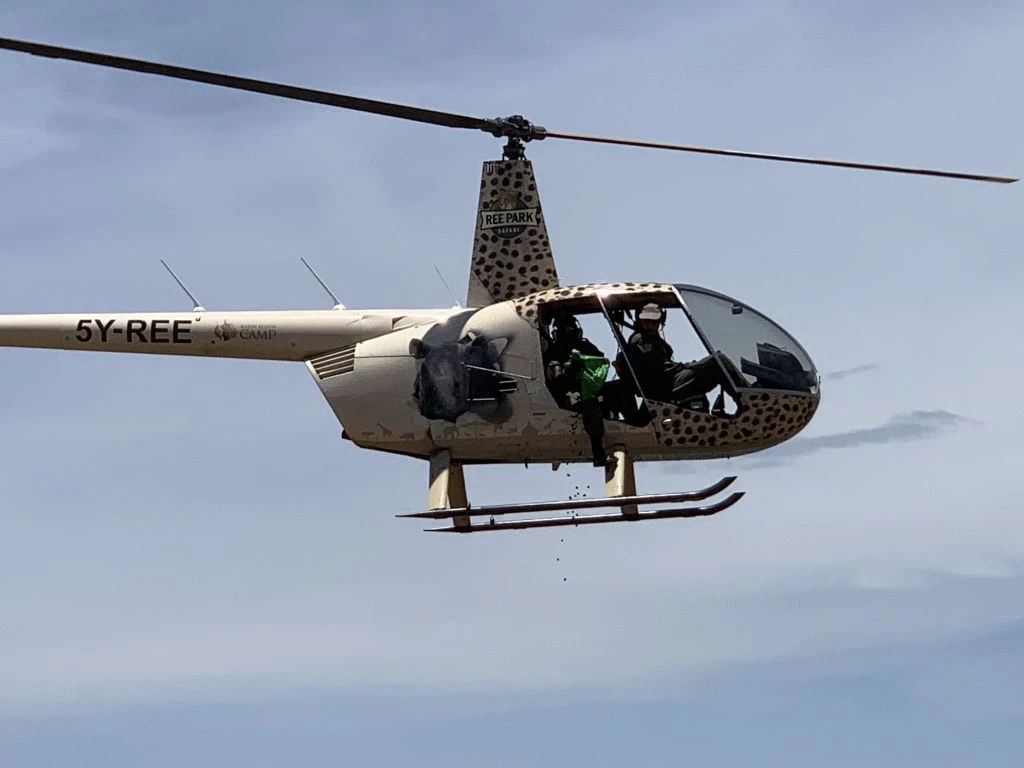
Picture a world where every gunshot plants a tree, where instead of heralding destruction, it signals the birth of new life. Well, that’s a tad dramatic, perhaps, but then we are in the business of saving the planet here. And today, we’re hopping onto a flight of fancy to the captivating land of Kenya, a country known for its stunning landscapes and diverse wildlife. But, alas, not everything is rosy in the garden…or should we say, not in the ‘forest’.
Kenya has lost a significant chunk of its forest cover over the years. Our ever-ravenous hunger for land, coupled with climate change’s cruel whims, has left just about 7% of the country green. If Mother Nature was a chef, Kenya’s meagre forest cover would barely pass as a garnish on her hefty green platter.
But lo and behold, amidst this canvas of despair emerges a knight, not with a shiny sword, but with a sack full of seeds and a wicked aim. Meet Seedballs Kenya, an initiative that’s turning the tide, one seed ball at a time.
Seed Balls, for those scratching their heads, aren’t a trendy new health snack, but they are healthy… for our planet, that is. They are essentially seeds – the proverbial phoenixes poised for rebirth – enrobed in a protective layer of charcoal dust. Think of this charcoal as a doting nanny, safeguarding her tiny charges from predators and the harsh Kenyan climate until the rain showers come calling, coaxing the seeds out of their comfy nests.
So, how does this magical transformation from seed to tree happen, you ask? Are industrious hands sowing these charcoal-coated bundles of hope across the land? Oh no, Seedballs Kenya wouldn’t let you off that easily. They’ve added a little twist to the tale. Something to get your adrenaline pumping, and your hands, well…flinging.
Imagine standing at the edge of a deforested area, a pouch full of seed balls at your hip, and a slingshot in hand. You pull back, aim, and let fly a seed ball. It soars through the air, a tiny dark speck against the blue sky, before disappearing into the distance. Soon enough, others join this first brave pioneer, dotting the barren landscape. It’s reforestation, but not as you know it. There’s no sweat-soaked soil tilling, no laborious digging, just the satisfying whir of seed balls cutting through the air.

Now, if that doesn’t make you feel like a planetary superhero, I don’t know what will. With a slingshot in hand and a bag of seed balls, you are no longer a passive bystander in the fight against deforestation. You are a warrior, wielding not a weapon of destruction, but of creation.
But before we get too carried away in this symphony of slingshots and seed balls, let’s dive a bit deeper. Let’s discover the ‘how’ behind this initiative. How did this small project turn into a movement, and why does it work so well? What makes it more than just a fun, feel-good exercise?
A Little Idea Grows Up: The Genesis of Seedballs Kenya

Seedballs Kenya didn’t just sprout overnight. It’s the brainchild of Teddy Kinyanjui, a Kenyan with soil in his blood and nature in his heart. The roots of this tree-planting revolution go back to Teddy’s childhood, growing up in a family that made efficient cookstoves. You see, Teddy’s family knew the worth of trees long before deforestation became a dreaded word. They were aware of the paradox that trees were being chopped down to fuel the stoves that cooked meals for the very hands that wielded the axes.
Fast forward a few years and add in the collaboration with a forest-friendly organization, Chardust Ltd, and Teddy’s brainwave turned into Seedballs Kenya. This collaboration brought together the strengths of both parties. Chardust Ltd provided the charcoal dust, a waste product from their operations, and Cookswell Jikos brought the seeds, specifically selected for the local environment.
The Science of Simplicity: Why Seedballs Work
Let’s move from the ‘who’ and ‘how’ to the ‘why’. Why do seed balls work, and how are they more efficient than traditional tree planting? Well, it’s all down to three key ingredients – strategy, season, and a dash of serendipity.
The seed balls are strategically launched during the rainy season, the time when nature herself turns into a nurturing greenhouse. The charcoal coating absorbs the rainwater, cueing the seed to germinate. At the same time, the coating prevents the seed from drying out in the harsh sun or becoming an impromptu snack for birds and insects. This gives each seed ball a higher chance of survival compared to a traditionally planted seedling.
But we’re not done yet. Remember that dash of serendipity I mentioned? Well, it’s all about location, location, location. By using the slingshot method, or as I like to call it, the “give it a whirl and see where it lands” technique, seed balls can cover areas that are usually hard to reach, such as steep slopes or dense undergrowth. This increases the potential for reforestation in places traditional methods can’t reach.
And there’s another advantage. Have you ever tried convincing a child to plant a tree? It’s not an easy sell. But hand them a slingshot and a pouch full of seed balls, and watch their eyes light up. The gamification aspect of Seedballs Kenya has helped involve not just adults but the younger generation in this crucial mission.
So, Seedballs Kenya is not just a project, it’s an idea – an idea that proves we can restore our planet while having fun. It’s an initiative that brings together conservation, community, and creativity in a delightful cocktail of change. But hold on to your hats, folks, the show isn’t over yet. There’s still more ground to cover, more seeds to sow…
The Score Sheet: Impact and Achievements of Seed Balls Kenya
Since Seedballs Kenya sunk its roots in 2016, the impact has been nothing short of a tree-hugger’s dream. So far, over 31 million seed balls have been slingshot into the Kenyan landscape. That’s millions of potential trees, each one a symbol of hope for our planet.
But it’s not just about the numbers. The beauty of Seedballs Kenya is in the ripple effect it creates. It’s not just planting trees; it’s about rethinking reforestation. It’s about changing our approach from laborious, resource-intensive tree planting to a simpler, smarter, and more fun way. It’s also about creating awareness, nurturing love for the environment, and showing that each one of us can make a difference.
Seedballs Kenya has also contributed to local economies. Charcoal waste, once a nuisance, now has a purpose and value. And let’s not forget the jobs created in making and distributing the seed balls. In short, it’s a win-win-win for people, planet, and profit.
Eyes on the Horizon: The Future of Seedballs Kenya

While Seed Balls Kenya has achieved remarkable success, there’s still a long way to go. Kenya’s forests are still under threat, and there’s an urgent need to accelerate reforestation efforts. Teddy and his team are constantly exploring ways to expand the project, improve the seed ball technology, and involve more people.
One of the future objectives is to increase the diversity of tree species in the seed balls, especially species that are native and beneficial to local ecosystems. They also want to collaborate with more organizations, schools, and communities, spreading the seed ball revolution far and wide.
Final Thought: Why Initiatives Like Seedballs Kenya Matter
Seed Balls Kenya isn’t just a story about planting trees. It’s a story about innovation, collaboration, and resilience. It’s about understanding our relationship with nature, recognizing our responsibility, and taking action in a way that’s sustainable and inclusive.
The beauty of initiatives like Seedballs Kenya is that they challenge our preconceived notions. They make us realize that solutions to our environmental problems don’t always have to be complicated or expensive. Sometimes, they can be as simple as a seed inside a charcoal ball.
So, the next time you feel overwhelmed by the environmental challenges we face, think of Seedballs Kenya. Think of the millions of seed balls now sprouting into trees. And remember that change is possible, that hope is alive, and that we all can play a part in shaping a greener future.
Remember, folks, the world needs more than armchair environmentalists. It’s time to stand up, roll up our sleeves, and get a bit of dirt under our fingernails. Or in this case, a bit of charcoal dust. Because as Seedballs Kenya shows us, saving the planet can be dirty work – but boy, is it worth it!
This is our planet, our responsibility, our chance to make a difference. So let’s get slinging, folks, because every seed ball counts, and every tree matters!

